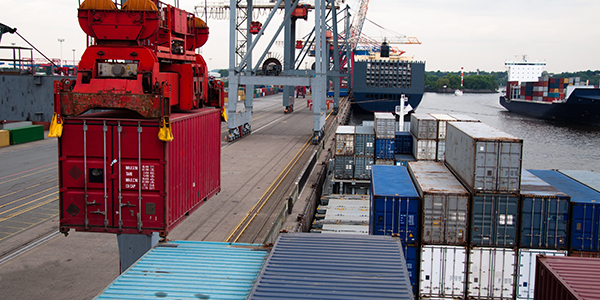The Swedish National Road and Transport Research Institute, VTI, is one of several important partners in a project whose purpose is to create knowledge and insight regarding the transport sector. In an initial subproject, VTI has produced a manual on transport, logistics and multimodality.
The manual deals with the entire freight transport system and explains the logistics structure, principles of market functions and how multimodal transport (transport with two or more modes of transport) works and can be streamlined etc.

“Reloading goods entails a cost that transport companies usually want to avoid.” Mostphotos
VTI provides several contributions to the FALCON* project. According to principal investigator Inge Vierth, the reason is VTI’s strong competencies within areas such as road transport vehicles, infrastructure, transport economics and logistics.
“We are producing a status report and analysis concerning the future of the freight transport system. That is, how different factors will affect the system,” says Inge Vierth, who has been in charge of the first FALCON subproject.
Manual with up-to-date knowledge
The manual is aimed at national road transport authorities, other infrastructure actors and operators within the freight transport sector. They require an up-to-date and forward-looking knowledge base to be used for good decision-making for the future. A pervading factor in the project is the climate and environment issue and the challenges posed by national and international goals. For example, in Sweden, greenhouse gas emissions from domestic transport shall be reduced during the period 2010-2030 by 70 per cent.
“If freight transport increases as forecasts predict, then everything else will increase accordingly, including emissions. This is perhaps the most important departure point along with the goal to reduce the number of fatalities and serious injuries in traffic.”
In order to achieve set climate and environmental goals, the increasing emissions of greenhouse gases and air pollution must be reversed. Freight transport is an obvious part of the problem. One measure that can be implemented to slow down development is to utilise existing vehicles more efficiently. This is clearly a necessity as, among other things, a broader breakthrough for electric propulsion and alternative fuels is still years away.
“Other issues mentioned in the manual include electric freight transport vehicles, convoy driving and self-propelled driverless freight vehicles. In some of these areas there is fairly mature technology, but there are still several steps before practical application on a larger scale,” says Inge Vierth.
The manual also describes how companies reason when choosing modes of transport. The choice is largely governed by transport costs, but also by factors such as delivery reliability and delivery time. For example, the time aspect is an important consideration for fresh produce within the food industry. For goods that are often subject to theft, the security aspects are a determining factor.
“In the end, transport costs, as in the price of the transport, are the most important decision factor. But basic requirements such as reliability and security must be met,” says Inge Vierth.
Rail and sea transport more energy efficient
In general, rail and sea transport are more energy efficient – and result in lower emissions per tonne and kilometre – than road transport. However, conveying goods by truck has logistical advantages, as it means that goods can be taken from door to door, while trains and boats usually require transshipment.
“Reloading goods entails a cost that transport companies usually want to avoid. Therefore, today it is often difficult to compete with door-to-door truck transport, which is also relatively inexpensive. This is especially true for short transport runs and the shipment of smaller consignments.”
Part of the manual therefore deals with the possibilities of combining different modes of transport in a transport chain. Linking together, for example, trains and trucks requires the streamlining of transshipment terminals, which in many cases can be done through shorter waiting times and reduced administrative holdups.
The manual also presents some national and international freight transport models. For example the Swedish Samgods model, which is used to analyse how different types of measures impact transport and traffic flows. According to Inge Vierth, it can be used for example to simulate the impact of infrastructure investments or fees for traffic in and outside Sweden or in a local context.
“Freight transport models are an important complement to statistics which, in a comprehensive way, describe how the transport system is used today. They can provide important information on the infrastructure’s capacity to handle the quantities of goods indicated in forecasts for the future.”
* FALCON stands for “Freight And Logistics in a Multimodal Context”.
Facts about the project
The project has been initiated by CEDR (Road Directors’ platform for cooperation and promotion of improvements to the road system and its infrastructure, as an integral part of a sustainable transport system in Europe.) Financed countries are Sweden, Germany, the Netherlands, and Norway.
 Contact:
Contact:
Inge Vierth
inge.vierth@vti.se
VTI, Sweden






Follow us: